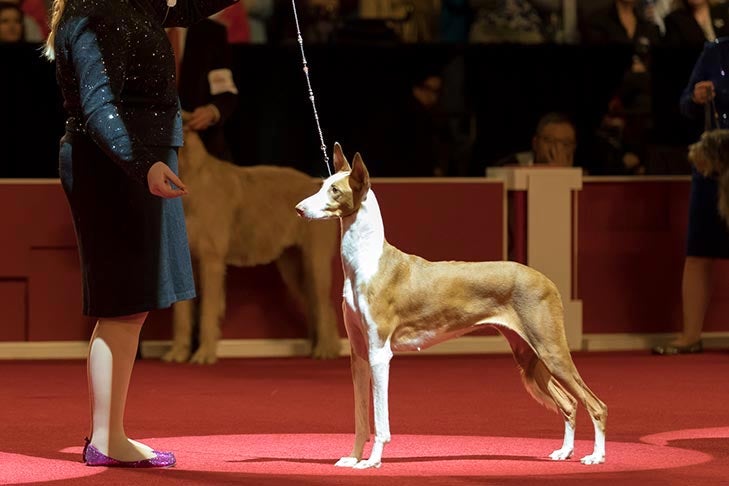
|
Let’s be honest: We are not Honey Boo Boo.
If you’re not part of the world of dog shows, I can see how you might think they are beauty contests for four-leggers, only with rosette ribbons in place of rhinestone tiaras. Admittedly, some coated breeds do use their fair share of hair spray – and even hair extensions if you’re in the Poodle ring.
But – whether you’re trotting around the ring or around the block during your daily jog. And a dog doesn’t have to be limping to give you evidence that he’s not built to go the distance: If your eye has been trained to look for it, little hiccups in movement and structure can signal the potential for weakness and injuries to come.
“He has such a beautiful prance,” puppy owners will tell me, describing what they see when their dog is moving freely around their property, motoring over to check if that squirrel has dared to reinsert himself among the azaleas. In fact, the dog is likely doing anything but prancing, which is a high, springy gait – not the smooth, efficient, ground-covering trot that I know they are seeing. But I think they use – or, as the case may be, misuse – the word to describe movement that even to their untrained eye seems smooth, functional and, well, sound, even if they don’t quite know the jargon for it.
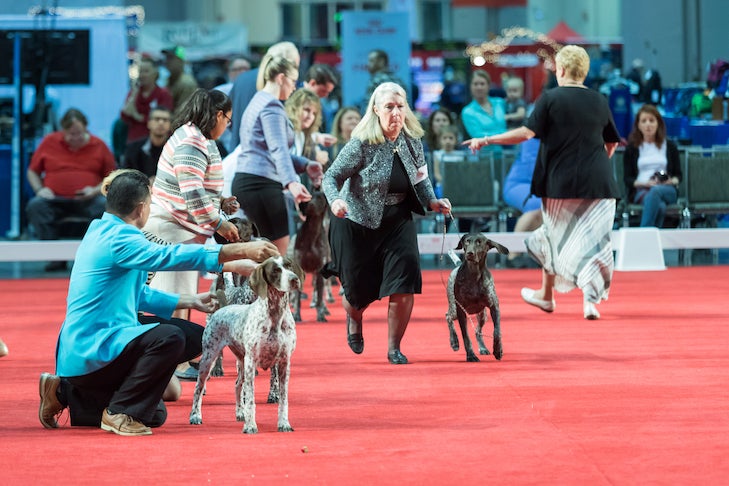
For all our desire to understand dogs and how best to care for them, we as a dog culture are woefully undereducated about the basics of canine anatomy and construction, and how they translate to our dogs’ well-being. If you have a dog with a brachycephalic, or pushed-in face, you know not to let him overheat in hot weather. If you have a dog who’s hairless, you’re going to apply sunscreen before going out on a summer outing, or a coat if it’s the dead of winter.
And if you have a dog who has a structural weakness, why wouldn’t you factor that into the activities you let him take part in? Most of the time, it’s because you don’t know that deficiency exists in the first place. And dogs, in their constant desire to please us and do what we ask of them, often don’t give us clear signals that something is uncomfortable or painful.
A disclaimer before we begin: Every breed is different because different purposes require different structures. While all dogs should have a basic soundness that ensures their quality of life, their construction varies depending on breed and purpose. Toy dogs, for example, which were created primarily for companionship, aren’t going to have the stamina of Retrievers. Similarly, Greyhounds, which are sprinters, aren’t going to have the same structure as endurance trotters like Dalmatians. And if you have a dog that’s has been bred randomly instead of purposefully, all these same assessments apply: A sound dog is a sound dog, whether or not she has a pedigree.
Gait Analysis
The way a dog is constructed reveals itself in how the dog moves, which is why dogs are evaluated both standing and moving at dog shows. While some breeds are not natural-born trotters, that is the gait at which dogs are judged at dog shows.
And that’s because the trot is such a useful and energy-saving gait: All the exertion is divided equally over all four limbs, it’s easy for the dog to keep balanced, and it’s an ideal gait for traversing large distances, even if the terrain is uneven. Wild animals naturally trot when they are looking for food, and all domestic quadrupeds use the gait as well. In old African safari books, I’ve even come across photos of a rhinoceros trotting as smartly as a terrier.
The trot is a rhythmic two-beat diagonal gait, which means that the two limbs on the right and left side of the dog, respectively, move in unison to support his weight. So, on one side of the dog, let’s say the left, the front and rear legs are under the dog, forming a column of support, with the rear leg ready to drop into the place of the left front leg in the next split second. Meanwhile, on the right side of the dog, the front and rear legs are in the opposite position, fully extended.
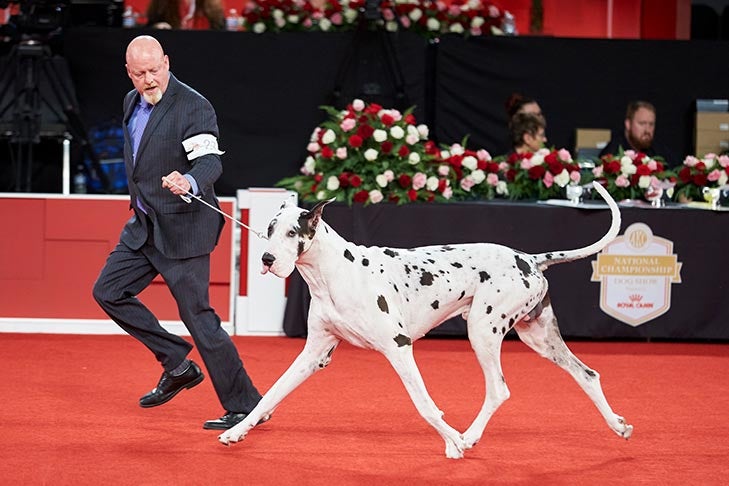
With most breeds, what you want is a smooth, effortless trot – nothing jarring, no interference between the feet or legs as the dog gains speed. That said, some breeds roll as they trot – in other words, you see a bit of side-to-side movement. You’ll find that in Bulldogs, for example, as well as in breeds with who carry a great deal of weight and substance, such as Neapolitan Mastiffs. Both those breeds weren’t bred to be endurance trotters, and hopefully, if you own one you don’t plan on taking him on a 5k run.
Watching a dog trot from the side can give you a wealth of information about how that dog is structured. If the dog takes short, mincing front steps, or has to lower her head in order to extend her front leg to prevent it from colliding with the rear one, you know to take a closer look at her front structure. Similarly, if she reaches by extending her front leg out from the elbow instead of the shoulder – if you see a pronounced “crack” at the elbow, instead of one relatively unbroken line from the shoulder to the toe – she is also likely not built correctly in the front end. If she is out of balance – if she is too short-bodied, or her rear is too angled for her front – then she might crab or sidewind, literally torquing her body sideways so her rear feet don’t strike her front ones when she moves.
Dog breeders and handlers have evolved a number of evocative names to describe movement faults – pounding, paddling, goose-stepping, to name a few. But the take-home message is that any imbalance or shortcoming in a dog’s structure can contribute to the dog breaking down over time.
The Rear View
In addition to circling around the ring at a trot, every dog at a dog show is asked to move away from the judge and then back again in a straight line. This “up and back” affords the judge a different view of the dog’s anatomy and how it works on the move. As the dog gaits away, the judge can gauge the strength of the rear assembly, and on the return trip, she can assess factors like elbow placement and whether there are any deviations from normal front movement, like toeing out (where the forefeet point outward) or paddling (in which the pasterns and feet flip forward to artificially lengthen the stride at the trot).
As in the side view, the key is to look for a smooth, effortless, balanced movement. In many breeds, especially those that are bred to work in the field, the dog’s legs will naturally begin to converge on a center line as the dog gains speed and trots away. This is called single-tracking: If your dog was trotting away from you in the snow, all you would see would be one single file of tracks. (Veterinarian and structure maven Chris Zink simulates this at her seminars, dipping a demonstration dog’s feet in chalk and having him gait over the floor.)
A dog’s rear quarters are his propulsion mechanism. When a dog jumps, he naturally pushes off from his rear. So weaknesses here can have orthopedic consequences if you stretch his abilities too far.
Consider, for example, a weak hock. More correctly called the rear pastern, this is the ankle area of the dog, extending from the foot up to that little round knob that’s called the hock joint. If the rear pasterns are so high or weak that they comprise stability, a judge can see that as the dog moves away: Depending on where the weakness is, the rear pasterns might rub together, or move wide, or even wobble.
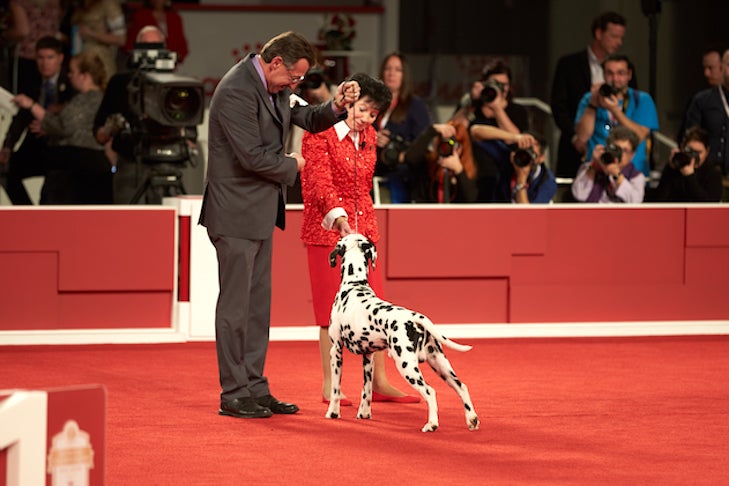
Earlier this year, one of my puppy people brought me over their yearling dog to evaluate. Periodically, while playing hard at the dog run, Simba would come up lame. Concerned, they took him to the vet to have his hips checked, but all was fine there.
The vet may have been stumped, but I could see the problem: Simba had hocks that were somewhat high, and his croup (the area which starts at the pin bones and end where the tail insets) was steeper than the ideal, making it difficult to get his legs out from under him. Together, both these conformation faults contributed to instability in his rear, which made it easier for him to injure himself roughhousing.
While we couldn’t change Simba’s conformation, we could strengthen it. I suggested hill work: Walking up and down inclines, eventually graduating to figure eights, can help build muscles to compensate for weakness elsewhere. I also suggested core-strengthening exercises on canine-conditioning equipment like a peanut-shaped stability ball.
While lax hips weren’t Simba’s problem, I have a friend with a Newfoundland with less-than-ideal hips who used daily core-training to help improve his stability. Building up his rear-leg muscles helped stabilize his pelvic area and made him much steadier on his feet.
Straight shoulders
The holy grail in many breeds, especially those bred for endurance – trotting, retrieving or generally working all day – is a “good front.” The front assembly of a dog involves a number of inter-related factors, including the length and angle of the upper arm; the depth and prominence of the prosternum, or forechest, and the length and arch of the neck. And central to the soundness of a front is the placement of the shoulder blade, or scapula.
The front end of the dog experiences the most wear and tear – 60 percent of the dog’s weight is carried on the front. When a dog jumps, he pushes off from his rear, so it’s important that he be sound, there, too. (And we’ll get to that.) But he when lands on his front, the scapula acts as a shock absorber, helping dissipate the concussion from that energy transmission.
The general rule is, the more sloped the scapula is, the more effective it will be at the job of shock absorption. Conversely, the straighter or more upright the shoulder, the less effective it will be, and the more the resultant pounding will wear and tear on the dog’s structure, setting the stage for orthopedic problems down the road.
The great irony of breeders who select for good fronts in their breeding stock is that the dogs with poorer fronts are often sold as pets, whose owners then use them as performance dogs.
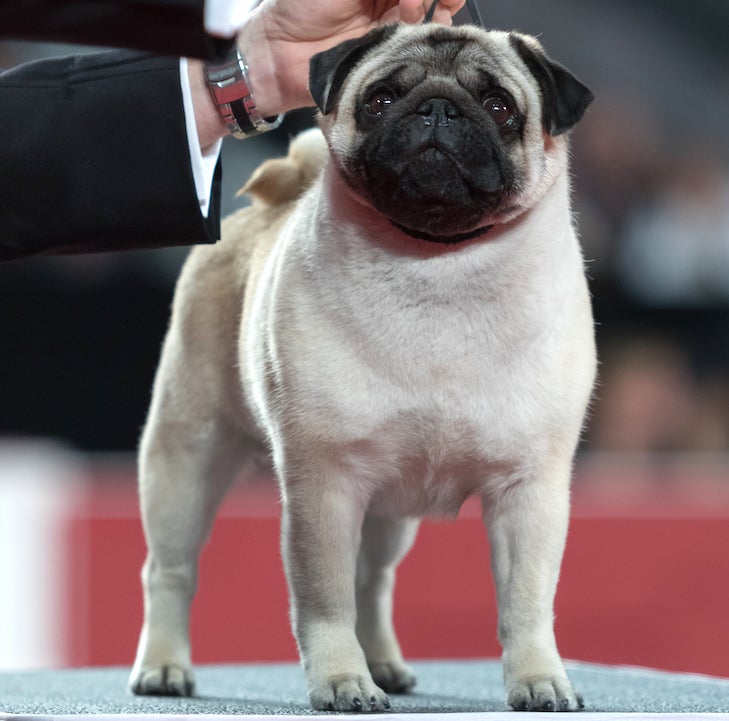
There is nothing you can do to change the scapula angle that your dog has: That’s genetically determined. But what you can do is avoid excessive wear and tear on your dog’s front whenever possible. If you have a straight-fronted dog that you want to work in agility, then think about jumps the way a dieter does calories: You want to save them up for when they really count, like at an official trial. Don’t reflexively jump your dog over every obstacle at practices or training class, the same way you might binge on potato chips during an “Orange Is the New Black” marathon. Be aware of how much concussion you are placing on that front end.
The list goes on and on: Virtually every part of a dog has functional implications. Consider, for example, feet. Most of us never do. But a dog with flat, thin, splayed feet won’t be able to travel comfortably on them for long, especially over uneven or rough ground.
Torn cruciate ligaments – the most common problem treated by veterinary orthopedists, and one that has been steadily increasing in the last several decades – also appears to have a connection to canine conformation. Breeders have long suspected that the width of stifle, or the knee joint, has a correlation to a predisposition to torn cruciate ligament. And a 2009 study pointed to tibial tuberosity – the protrusion on the front of the tibia to which tendons attach, suggesting that the narrower the tibial tuberosity, the greater the risk of ligament rupture. And newer studies with a focus on Labrador Retrievers are focusing on hind-limb conformation and gait, and how they impact CCL disease.
Educating Yourself
The study of canine conformation is a lifetime endeavor and not something you can master in one article. But, luckily, there are plenty of resources for you to kick off a lifetime of learning: For example, there are several courses you can take through the AKC Canine College.
Perhaps the best way to learn about canine conformation and how it impacts structure is to seek out a mentor who can literally show you what it’s all about. Many breeders and performance enthusiasts with an understanding of structure are often surprisingly happy to share their knowledge, as it can only help any dogs live happier, healthier, more comfortable lives.
The 2019 AKC National Championships presented by Royal Canin will take place Saturday and Sunday, December 14 and 15, 2019, in Orlando, Florida. Tune in to AKC.TV, or download the AKC.TV app on Roku, Apple TV, or Amazon Fire TV to catch the live stream.

